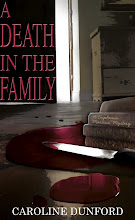In December 1909 the Reverend Joshia Martins expires in a dish of mutton and onions leaving his family on the brink of destitution. Abandoned by her noble grandfather, Joshia's daughter, the eighteen year old Euphemia, takes it on herself to provide for her mother and little brother by entering service. She's young, fit, intelligent, a little naive and assumes the life of a maid won't be too demanding. However, on her first day at the unhappy home of Lord Stapleford she discovers a murdered body.
Euphemia's innate sense of justice has her prying where no servant should look and uncovering some of the darker social, political and business secrets of Stapleford family. All she has to defend herself is her quick wits, sense of humour and the ultimate weapon of all virtuous young women, her scream.
Saturday 12 September 2009
Crime Launch nears
A Death in the family officially exists - it's on amazon, available for pre-order now!
Friday 11 September 2009
The Purpose of a Synopsis
Hands up anyone who enjoys writing a synopsis?
No hands in the room?
Hands up those who believe a synopsis is something you write immediately before you submit your completed manuscript to an agent or publisher?
Sadly, I suspect there are now a lot of hands in the air. Here's the thing, you do need to send a short, snappy and evocative synopsis with your submission - especially if you're hoping to rise to the top of the slush pile, but this synopsis should be a synopsis of your much longer structural synopsis.
And if you're anything like me you're groaning at the idea of yet more synopsis. But here's the thing, being a successful writer is hard work. You may have written your first draft in a state of almost euphoric imaginative outpouring, but if you did, unless you're luckier than the average lottery winner, it's going to need substantial tidying.
There are many ways of using synopsis to improve your writing. I'm going to give you two examples of how I use them and that reflect two very different ways of working. One is much less painful than the other.
When I'm writing the Euphemia Martins Mysteries (launched in October!!!!!) I spend a lot of time thinking about my next idea and the themes I want to weave in. I have a short overarching synopsis that covers the entire series and first of all I need to pinpoint where this story falls on the series arch. Then I write the first chapter to get a feel for the book. I know even at this point that the first chapter will be rewritten and tightened several times, but it gives me the sense of the book. I then, before writing any more chapters, go on to write a detailed structural synopsis. By this I mean a break down of each major scene. When I finally come to write the book I always know exactly where I am going. I may find when writing I need to include a small extra linking scene here and there, but generally I'm sticking to the original structural synopsis. That first draft will need some rework, but not that much. I've already ironed out much of the issues in the original synopsis.
With the young adult (YA) novel I've been writing for my Scottish Book Trust mentorship I gave myself much more work. I wrote the better part of the book, pausing two thirds of the way through to pull together a synopsis, much of which was based on what I had already written. This was always intended as a rough first draft. What I wanted was a body of prose to work with during the mentorship. (That's my excuse and I'm sticking to it.) I've now rewritten the book several times. The second time through was to expound on a lot of the world building ideas I had in my head rather than on the page. Before the third time through I rewrote a long structural synopsis to pull the story into better shape and then followed this with another draft. I have just completed what I hope will be the last, and very long, structural synopsis that weaves various scenes in and out to (again I hope) create a fast paced story in a world that is complex, fantastic and full of peril.
In both cases I've used the synopsis to get the book under control and decide what it was about rather than to sell it.
The Euphemia Martins' stories are set in this world shortly before WWI. In these I have to track the on-going journey of several continuing characters and ensure the parts of my crime slot together well and clues are scattered throughout the novel at an appropriate rate. But here I'm working in a setting that is familiar to most of my readers and also using the tight, tight structure of crime. My use of synopsis limits the number of rewrites I need and ensures right from the start I know I'm on the right track.
In the YA I've written directly from my imagination and paid the price in extra work. But here, I'm not sure I could have done it any other way. I have to allow the rules of my world to filter through as I am showing the story. There is a lot of new information - a reader needs to know everything from how many suns there are in the sky to why the world is in peril - there is little assumed knowledge. To allow the reader to engage with this new world in an entertaining, rather than confusing, manner, as well as ensure the usual plot elements (characterization, character journey, pacing, etc) I have to weave in scenes that show how this new and strange universe works. I also have to anticipate the reader - for example I have to show their are two suns before the reader assumes there is one. Using a structural synopsis allows me to ensure the building blocks of the story all stack up to a complete and exciting story.
I'm pretty sure some of you are thinking this all all very well, but that in your case your novel means you don't need to do a structural synopsis.
Okay, there have been some amazing stream of consciousness writers (like Kerouac and Joyce), and they may appear to be the exceptions to the rule. However, even these seemingly roving tales have an inherent structure when you break them done.
Loose writing doesn't find much favour in today's world of busy, stressed readers, who snatch their reading time between the ever increasing demands of modern life. You can't risk losing their attention for a moment or before you know it your book is doing it's bit for the planet in the recycle bin.
So, no, I don't think any of you can get away without working your way through at least one structural synopsis. At least when you've done it you have something to synopsis your submission synopsis from.
Go on, you never know you might enjoy it. Your readers certainly will appreciate your efforts.
Subscribe to:
Posts (Atom)







